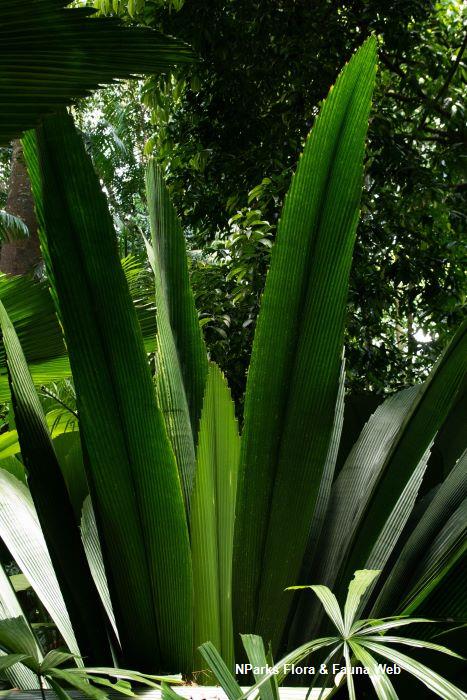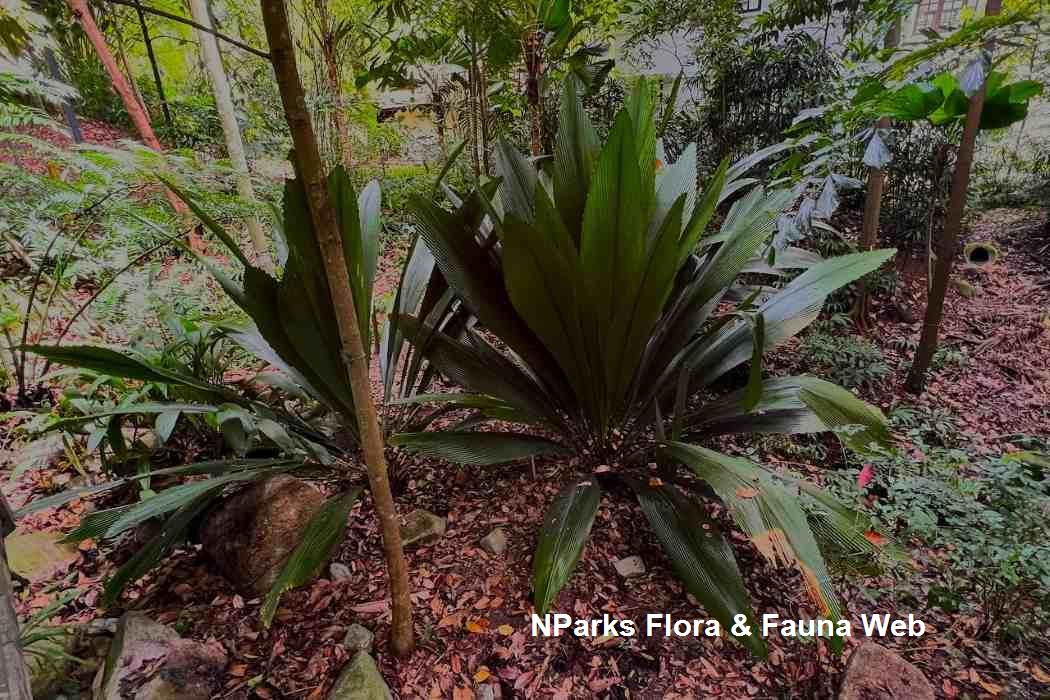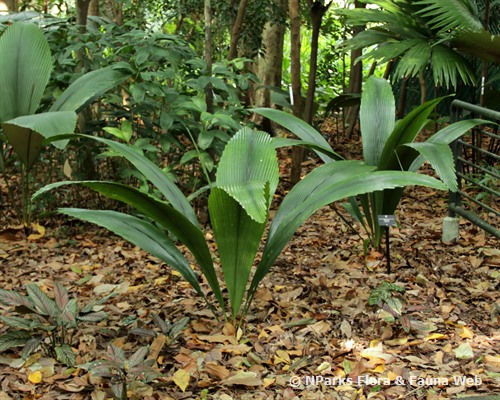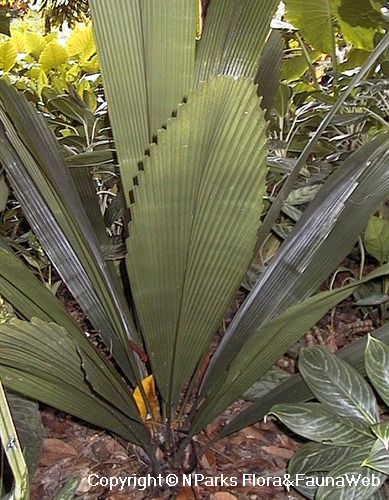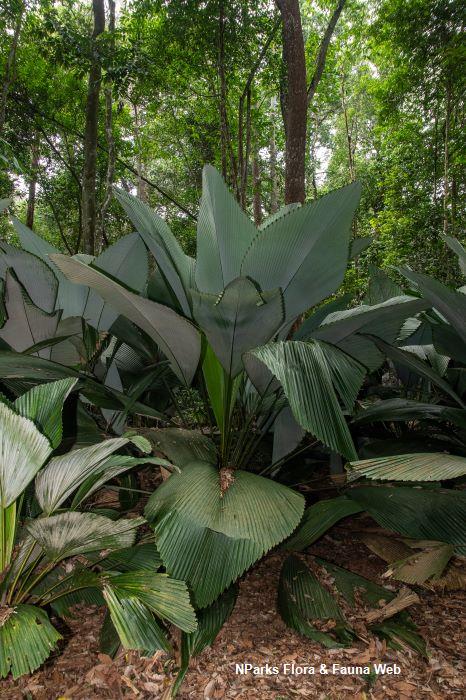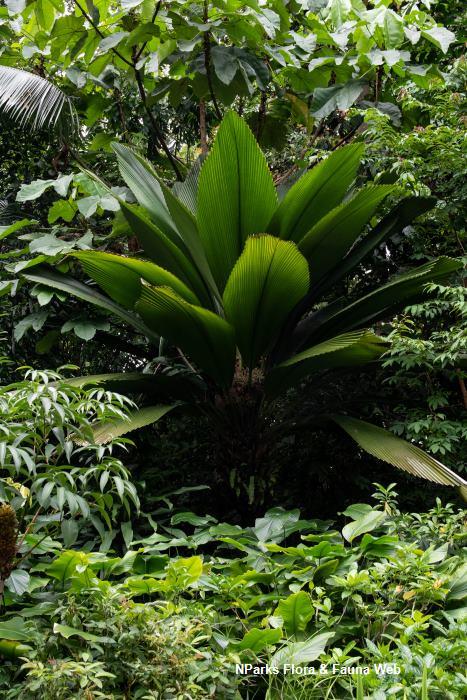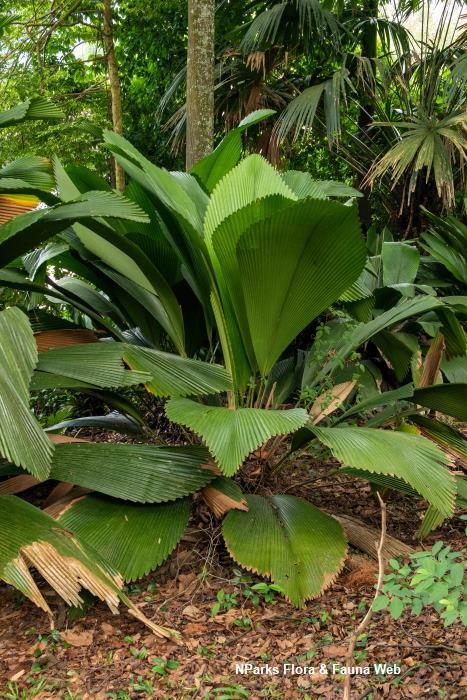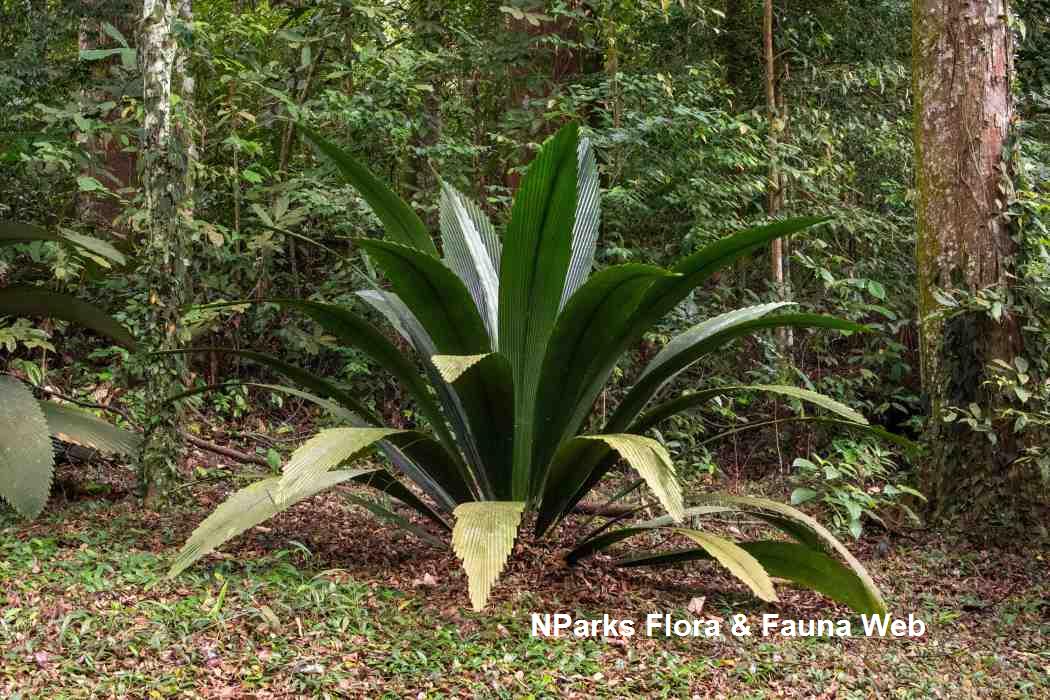
Back
Johannesteijsmannia lanceolata J.Dransf.
| Family Name: | Arecaceae (Palmae) |
| Common Name: | Slender Joey, Narrow-leaved Umbrella Palm |
Johannesteijsmannia lanceolata, or known as Slender Joey, is a slow-growing, solitary, 'stemless' understorey palm found in Peninsular Malaysia. It produces long, pleated, lance-shaped, undivided fronds that can reach up to 3.5 m in length, and a cluster of minute white odorous flowers, arranged on short, thick branches. The palm prefers well-drained soils and a humid, shaded environment.
Name
Classifications and Characteristics
| Plant Division | Angiosperms (Flowering Seed Plants) (Monocotyledon) |
|---|---|
| Plant Growth Form | Palm (Solitary Habit) |
| Lifespan (in Singapore) | Perennial |
| Mode of Nutrition | Autotrophic |
| Maximum Height | 3.5 m |
| Maximum Plant Spread / Crown Width | 5 m |
Biogeography
| Native Distribution | Peninsular Malaysia |
|---|---|
| Native Habitat | Terrestrial (Primary Rainforest) |
| Preferred Climate Zone | Tropical |
| Local Conservation Status | Non-native (Horticultural / Cultivated Only) |
Description and Ethnobotany
| Growth Form | It is a small to medium-sized solitary palm, with fronds reaching up to 3.5 m in height. The large surface area and the rosette arrangement of the fronds might suggest a litter-trapping habit, funnelling leaf litter and debris to the base of the stem. <3> |
|---|---|
| Foliage | The undivided fronds are erect to spreading, long (up to 3.5 m long × 30 cm wide), glossy, pleated, and lance-shaped. The undersides are covered with soft, brown scales, and the lower frond margin is armed with small, sharp spines up to 1mm. The petiole (leaf stalk) has two lateral yellow stripes. |
| Stems | It is acaulescent (seemingly stemless, with non-visible stems in palms), with a subterranean stem up to 15 cm. |
| Flowers | The inflorescence is an interfoliar (borne between the leaves/fronds) panicle, often buried between the petioles under dead leaves and debris, and subtended by 2 - 4 spathes or peduncular bracts. The spathes are covered in scruffy fuzz that starts cream-coloured before turning brown. The peduncle (central stalk on inflorescence) can be up to 25 cm long and branches up to 1 order with 3 - 6 thick rachillae (minor, secondary axes on inflorescences), each up to 16 cm long × 1 cm in diameter. The bisexual flowers occur singly or in groups of twos or threes, and are arranged spirally throughout each rachillae. The flowers are white and sessile with three papillate (covered in small, soft projections) petals. The flowers are odorous, emitting a faint, sour scent. |
| Fruit | The fruit is a globose, brown drupe (a fleshy fruit with thin skin and a single central seed) with numerous corky protuberances. |
| Habitat | It can be found in hilly dipterocarp forest and on the steep banks of a forest river in a deep, humid valley, growing alongside Johannesteijsmannia magnifica. Despite its proximity to the river, it grows in well-drained soil, not in low, swampy ground at the river's bends. |
| Similar | This species can be distinguished from other Johannesteijamannia species by its narrow fronds, thickly-branched inflorescence, and flowers with papillate petals. <2> |
| Associated Fauna | The flowers are likely pollinated by stingless bees (genus Trigona). <1> |
| Cultivation | It requires bright, filtered light or dappled shade and a warm, humid environment. It prefers moist, well-drained soil with high organic matter and is sensitive to overwatering. Avoid strong winds and root disturbance, as it will stress the palm. It can be grown indoors but requires high humidity. It can be propagated by seeds. |
| Etymology | The genus Johannesteijamannia is name in honour of Johannes Elias Teijsmann (1808 to 1882), a Dutch gardener and botanist at the former Buitenzorg Botanical Garden, Java (now Kebun Raya Indonesia, Bogor). The specific epithet lanceolata is Latin for 'lance-shaped', referring to the shape of its fronds. |
| Ethnobotanical Uses | Others: The fronds are commonly used for thatch by the natives in its region. |
Landscaping Features
| Landscaping | It is suitable for growing in parks under shady, humid conditions. It can be grown as a focal plant for its handsome form and attractive, lance-shaped fronds. Avoid areas with strong winds, such as exposed areas and high-traffic roadsides. |
|---|---|
| Desirable Plant Features | Ornamental Form, Ornamental Foliage |
| Landscape Uses | Parks & Gardens, Focal Plant, Container Planting, Interiorscape/ Indoor Plant |
| Thematic Landscaping | Naturalistic Garden |
| Usage Hazard - Cons | Spines/Thorns - Leaf, Pungent Scent - Flowers |
| Usage Hazard - Cons Remarks | Spines/Thorns (Leaf): The lower leaf margin and petiole are lined with short spines. Pungent Scent (Flowers): The flowers are odorous, emitting a faint sour scent. |
Fauna, Pollination and Dispersal
| Pollination Method(s) | Abiotic (Self-Pollinated), Biotic (Fauna) (Insects (Bee)) |
|---|
Plant Care and Propagation
| Light Preference | Semi-Shade, Full Shade |
|---|---|
| Water Preference | Moderate Water |
| Plant Growth Rate | Moderate to Slow |
| Rootzone Tolerance | Fertile Loamy Soils, Well-Drained Soils |
| Transplanting Tolerance | Poor / Sensitive |
| Maintenance Requirements | Moderate |
| Propagation Method | Seed |
Foliar
| Foliage Retention | Evergreen |
|---|---|
| Mature Foliage Colour(s) | Green |
| Mature Foliage Texture(s) | Glossy / Shiny, Leathery |
| Foliar Modification | Flower/Fruit Bract, Spine (marginal) |
| Foliar Type | Simple / Unifoliate |
| Foliar Arrangement Along Stem | Spiral |
| Foliar Attachment to Stem | Petiolate |
| Foliar Shape(s) | Palm Fronds (Simple) |
| Foliar Venation | Parallel |
| Foliar Margin | Spiny, Entire |
| Leaf Area Index (LAI) for Green Plot Ratio | 2.5 (Palm - Solitary) |
Non - Foliar and Storage
| Trunk Type (Palm) | Solitary Habit |
|---|---|
| Stem Type & Modification | Acaulescent |
| Root Type | Underground (Fibrous Root) |
Floral (Angiosperm)
| Flower & Plant Sexuality | Bisexual Flowers |
| Flower Colour(s) | White |
|---|---|
| Flower Texture(s) | Bumpy / Tuberculate, Thick / Fleshy |
| Flower Grouping | Cluster / Inflorescence |
| Flower Location | Axillary |
| Flower Symmetry | Radial |
| Inflorescence Type | Panicle |
| Ovary Position | Superior / Hypogynous |
| Flowering Habit | Polycarpic |
Fruit, Seed and Spore
| Mature Fruit Colour(s) | Brown |
|---|---|
| Mature Fruit Texture(s) | Bumpy / Tuberculate |
| Fruit Classification | Simple Fruit |
| Fruit Type | |
| Seed Quantity Per Fruit | Few (1-5) |
References
| References | <1> Chan, Y.M., & Saw, L.G. (2011). Notes on the Pollination Ecology of the Palm Genus Johannesteijsmannia (Arecaceae). Journal of Pollination Ecology, 6(15). pp 108–117
<2> Dransfield, J. (1972). The Genus Johannesteijsmannia H. E. Moore Jr. Gardens' Bulletin, Singapore Vol. 26. pp 63–83. <3> Zona, S., & Christenhusz, M. J. M. (2015). Litter-trapping plants: Filter feeders of the plant kingdom. Botanical Journal of the Linnean Society, 179, pp 554–586. |
|---|
Image Repository
Others
| Master ID | 1341 |
|---|---|
| Species ID | 2634 |

